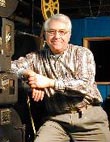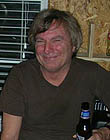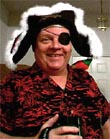|
|
This topic comprises 3 pages: 1 2 3
|
|
Author
|
Topic: Speaker Wire
|
|
|
|
|
|
|
|
|
Paul G. Thompson
The Weenie Man

Posts: 4718
From: Mount Vernon WA USA
Registered: Nov 2000
|
 posted 04-20-2002 02:36 AM
posted 04-20-2002 02:36 AM




Dave Macaulay is correct. Some amplifier operator's manuals have a chart which explains the damping factor characteristics. It is nothing more than an arbitrary number, but the higher the better. The chart usually gives an idea as what might be expected by the size and length of the wire used. The higher the number, the better.
| IP: Logged
|
|
|
|
|
|
|
|
|
|
|
|
|
|
|
|
|
|
Steve Guttag
We forgot the crackers Gromit!!!

Posts: 12814
From: Annapolis, MD
Registered: Dec 1999
|
 posted 04-21-2002 12:42 AM
posted 04-21-2002 12:42 AM




John,Check your math before giving someone bad advice. 14awg is often inadequate wire in theatre applications. Lets say your subwoofer line needs or will demand 2000 watts of power and you use say 4 8-Ohm subwoofers to handle the power and present a 2Ohm load to the amplifier...you will need nearly 32 amps of carrying capacity from your wire. 14awg won't cut it and you wont be blowing your speakers, necessarily. Heck, only 750 watts into an 4-ohm LF cabinet of a typical stage speaker (that can hanle 1200 watts) will bring you nearly up to 14amps. The JBL 4648-4, when driven to full power will draw over 17 amps without damaging the drivers. Instantaneous power consumption can double that! Both of the above examples are valid for typical theatres today. This isn't a case where we want the wire to current limit our signal either thus larger wire should be used. While damping factor is almost never a concern for speaker wire, power limiting is. As for THX, they do have their hand in choosing the speaker wire gauge. I believe it was HPS-4000 though that got on the Monster cable bandwagon. However, there are plenty of cases where 14awg is just fine. It really depends on the length of run and the power needed. BTW Carol and Belden also make fine jacketed red/black speaker cables down to 12awg. If you don't mind wht/blk then one can often go larger, West penn just introduced a 10awg. International Wire and Cable will make larger gauges in red/black...I've seen them use 10awg. Steve ------------------
"Old projectionists never die, they just changeover!"
| IP: Logged
|
|
|
|
|
|
All times are Central (GMT -6:00)
|
This topic comprises 3 pages: 1 2 3
|
Powered by Infopop Corporation
UBB.classicTM
6.3.1.2
The Film-Tech Forums are designed for various members related to the cinema industry to express their opinions, viewpoints and testimonials on various products, services and events based upon speculation, personal knowledge and factual information through use, therefore all views represented here allow no liability upon the publishers of this web site and the owners of said views assume no liability for any ill will resulting from these postings. The posts made here are for educational as well as entertainment purposes and as such anyone viewing this portion of the website must accept these views as statements of the author of that opinion
and agrees to release the authors from any and all liability.
|

 Home
Home
 Products
Products
 Store
Store
 Forum
Forum
 Warehouse
Warehouse
 Contact Us
Contact Us




 Printer-friendly view of this topic
Printer-friendly view of this topic



















